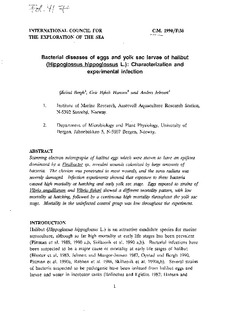| dc.contributor.author | Bergh, Øivind | |
| dc.contributor.author | Hansen, Geir Høvik | |
| dc.contributor.author | Jelmert, Anders | |
| dc.date.accessioned | 2012-08-21T14:33:01Z | |
| dc.date.available | 2012-08-21T14:33:01Z | |
| dc.date.issued | 1990 | |
| dc.identifier.citation | This report is not to be cited without prior reference to the authors | no_NO |
| dc.identifier.uri | http://hdl.handle.net/11250/104737 | |
| dc.description.abstract | Scanning electron micrographs of halibut eggs which were shown to have an epiflora
dominated by a Flexibacter sp., revealed wounds colonized by large amounts of
bacteria. The chorion was penetrated in most wounds, and the zona radiata was
severely damaged. Infection experiments showed that exposure to these bacteria
caused high mortality at hatching and early yolk sac stage. Eggs exposed to strains of
Vibrio anguillarum and Vibrio fisheri showed a different mortality pattern, with low
mortality at hatching, followed by a continuous high mortality throughout the yolk sac
stage. Mortality in the uninfected control group was low throughout the experiment. | no_NO |
| dc.language.iso | eng | no_NO |
| dc.publisher | ICES | no_NO |
| dc.relation.ispartofseries | ICES CM Documents;1990/F:38 | |
| dc.subject | mortality | no_NO |
| dc.subject | dødelighet | no_NO |
| dc.subject | bacterial diseases | no_NO |
| dc.subject | bakteriesykdommer | no_NO |
| dc.subject | halibut | no_NO |
| dc.subject | kveite | no_NO |
| dc.title | Bacterial diseases of eggs and yolk sac larvae of halibut (Hippoglossus hippoglossus L.): Characterization and experimental infection | no_NO |
| dc.type | Working paper | no_NO |
| dc.subject.nsi | VDP::Agriculture and fishery disciplines: 900::Fisheries science: 920::Resource biology: 921 | no_NO |
| dc.subject.nsi | VDP::Agriculture and fishery disciplines: 900::Fisheries science: 920::Fish health: 923 | no_NO |
| dc.source.pagenumber | 7 s. | no_NO |
